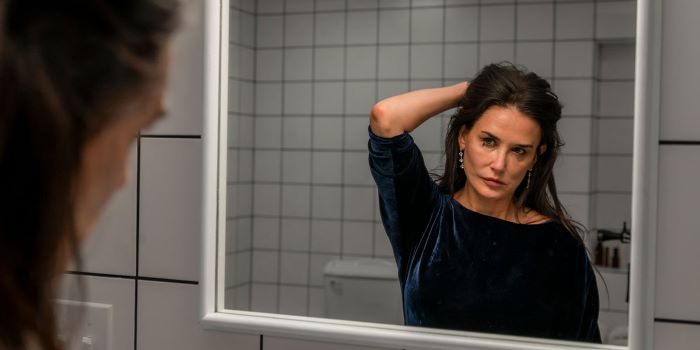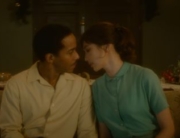![]() The well-worn Sunset Boulevard yarn of a Hollywood’s star’s fading relevancy gets a garish, unsubtle, and searing revamp in French filmmaker Coralie Fargeat’s explosive follow-up to her suspenseful, gnarly, desert-set Revenge.
The well-worn Sunset Boulevard yarn of a Hollywood’s star’s fading relevancy gets a garish, unsubtle, and searing revamp in French filmmaker Coralie Fargeat’s explosive follow-up to her suspenseful, gnarly, desert-set Revenge.
The punch and panache of textured, colorful imagery from that film is also on display here. Demi Moore, perfectly cast and transfixing, plays Elisabeth Sparkle, a former movie star now slumming it—albeit successfully—as a TV aerobics personality who lives a lonely existence in a condo up in the sky above Los Angeles. The décor of her pad, with its glass blocks, pastel colors, and ruby red landline phone, seems trapped in the early 1990s, perhaps when her stardom peaked.
Feeling depressed about aging after being fired—on her 50th birthday, no less—by her cruel, repugnant, and flagrantly misogynist boss, pointedly named Harvey (Dennis Quaid), she becomes interested in the Substance, a black-market cell rejuvenation program that promises renewed youth. It quickly reveals itself to be a more-than-one-bargained-for prospect. After she injects it, a whole new, younger self (Margaret Qualley) bursts out of her back. This queasy sequence is a tour-de-force of the film’s consistently excellent make-up, visual and prosthetic effects, and gooey, sludgy sound design. Qualley’s Sue replaces Elisabeth, but they are symbiotic with one another, all while under a weekly time limit where Elisabeth has to alternate with her younger self every seven days, with absolutely no exceptions.
The film alludes to and cribs from a menagerie of cinematic influences: Hollywood nightmares like David Lynch’s Mulholland Drive, the body horrors of Darren Aronofsky and David Cronenberg, and effects-heavy, camp ’80s horror flicks like The Stuff, Basket Case, and Society. It fuses its bonkers visual gags with renowned music cues from auteurs (Hitchcock and Kubrick) to amusing effect. Otherwise, Raffertie’s blaring, metallic techno score scrapes and stabs throughout.
Qualley’s Sue is a difficult role, perhaps because her character is so soulless. She embodies objectification to the extreme—the camera constantly highlighting her body, replete with slow-motion shots of her twerking. Could there have been just a shading of depth? Even a similar monster of sorts, Elsa Lanchester’s Bride of Frankenstein, displayed longing and fear in her brief runtime. Overall, the blankness of Sue’s character and her empty interests (the ceaseless pursuit of fame and hooking up with guys) also lack bite. Perhaps it is Fargeat’s intent to portray this emptiness without nuance. Nevertheless, Sue’s character may be unengaging, but her attempts to prolong her existence through the Substance by breaking its stringent rules are not.
In a powerhouse role, Moore believably portrays the gamut of Elisabeth’s emotional and physical anguish. In one sequence, she gets ready for a potential date and finds herself—in comparison to Sue (looming on a billboard up high, directly in front of her condo window, no less)—so incredibly imperfect that she violently adds more makeup to her face. It’s one of the less fantastical scenes, but it’s still harrowing, in part to Moore’s piercing performance and the skillful editing. (The film was cut by a trio of editors, including Fargeat, Jérome Eltabet, and Valentin Féron.)
The Substance, with its Jekyll and Hyde/The Fly junk science and hammered-out social commentary, wears its bombast proudly. The tone, performances, make-up effects, and style are often arch and extravagant. (The icky men are leering buffoons.) Yet the film gripped me from its humorous, eye-catching opening to the splashy (literally) finale, with its macabre images trapped in my head days after.

















Leave A Comment